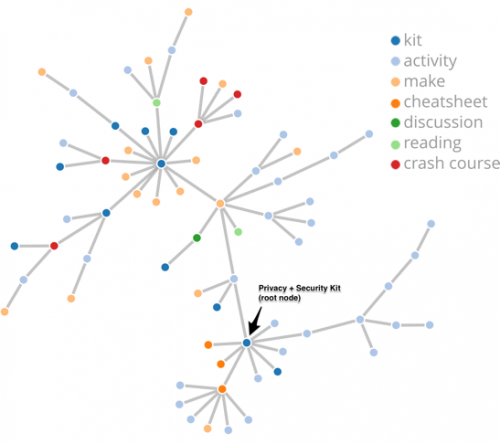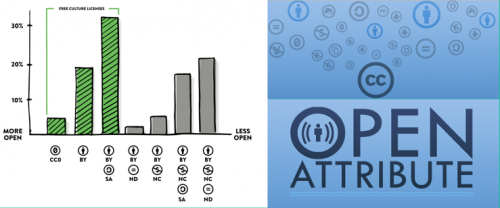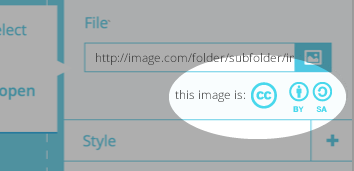Easier said than done. Back in the day, my amazing colleague Jess Klein made an epic PDF laying out a lesson plan for what was then known as Hackasaurus. People who teach started using it left and right, and when I saw it for the first time I thought “Holy moly that looks like a fun bit of curriculum.” But I didn’t need all of it. I only needed pieces and parts (many of which, BTW, are baked in, remixed and modified within Webmaker Teaching Kits), and so I started to think about the models we use when we make curriculum. The old smelly models that didn’t evolve as technology evolved.

I’ve always thought the models and systems could be better, so several years ago I started working on an educational model that centered on the idea that educators ALWAYS remix. I thought that if the model was clear, we could tackle the problems of OERs while making new curriculum to #TeachTheWeb. Fast forward about five years and the OER (open educational resources) movement has become something that is well known within the open and the educational communities. But people are still publishing their resources in ways that make remix hard, and as a result we edunerds tend to remix on the fly.
We implemented the model in HTML, creating overview pages that were separate from activities. The idea was to separate all the pieces and parts of curriculum – the learning objectives, the assessment criteria, the activities, the overviews – so that any one individual part could be remixed into a new bit of curriculum. We tried to lay this model out using the mechanics of the web to make the modularity and remixability clear, but we began to realize that
“No one remixes the HTML. It’s too high bar.”
So now, I’m trying to figure out how we can collect those on the fly remixes and get educators to understand how important their ideas and feedback is when it comes to learning materials. What works? What doesn’t work? How did someone remix context?
I think that Webmaker could become the clearinghouse for Web Literacy OERs, and to do so, I think remixability is key. I still think the model is solid, but we haven’t gotten to a place where remixing curriculum is common place. This post begins to explore WHY.
The Problems of OERs
1. Open Licenses are Confusing and Attribution is Hard
“confusion over copyright, fair use, and Creative Commons is one of things that makes many educators hesitant about adopting any new resources, licensing be damned.” – Audrey Watters
“Often resources using more open licenses incorporate or refer to media that are made available using a more restrictive license.” (Tel Amiel 2013)
In education there is “…still a limited understanding of how to move beyond some of the encumbrances— specifically with regard to reusing others’ content as well as more complex reuse behaviors that lead to new configurations of existing content” (Petrides et al., 2008, p. 352). (Tel Amiel 2013)
Users need to be able to contextualize credit depending on how they’ve used a resource.
- Is the resource BY someone who used an open license or is the user under Fair Use?
- Is the resource a light edit of someone else’s?
- Was the resource based on or inspired by someone else’s?
2. Users don’t have time to make the required effort
“Faculty consistently listed the time and effort to find and evaluate open educational resources as the most important barriers to adoption.” (Open the Curriculum 2014)
“Existing educational sites and repositories contribute to this concern. Most are focused on the distribution and dissemination of resources and provided little guidance or tools for those who wish to make revisions or remix existing resources.” (Tel Amiel 2013)
Staff (anywhere) rarely have the time to review all the resources submitted. We build software and communities though, so how can automation or, much more importantly, social evaluation make it easy for users to find quality curriculum?
3. There are technical barriers to remix
“When presenting OER development and use, many of the restrictions derived from our working scenario came to the forefront. In many cases, the source guides assumed a reader with substantial access to computer-based resources. “ (Tel Amiel 2013)
“The process of remix is usually associated with four steps: finding, relating, creating, and sharing resources…Many of the online portals, which contain more openly licensed resources either do not have alternative language interfaces or metadata, which impacts both finding and sharing resources in these sites.” (Tel Amiel 2013)
We have to design mobile-first and keep our need for localization at the forefront. We know this, but we also need to find more ways for lo-fi, no-fi communities to share their offline remixes (e.g. a couple of community managers does not a stable system make).
Towards Solutions

Make licensing and attribution easy, embedded. I’ll leave it to the amazing devs and designers to figure out what exactly that means, but building this into our tools from the onset is a way to encourage remix at all levels (both in learner focused and mentor focused content).

“Reuse is perhaps reminiscent of the rhetoric around learning objects as they were presented as blocks of media that could be reused and assembled for different contexts, a metaphor that did not hold in practice (Fulantelli et al., 2008; Gunn et al., 2005).”
Make remixability & modularity obvious and lean into social evaluation. This is as much about presentation as it is about functionality. We are missing context around our educational model. We’re starting to do that with the Club curriculum, where we are building resources on how to remix as well as giving examples of why and when and how we’ve remixed.
Build the thing that makes it easy for others to build their thing (no matter what device they have). As we build features for our communities, continuing to encourage open interaction is essential to changing the landscape of OERs (and open in general). What are the ways in which we can utilize existing systems to encourage remixable curriculum? We’ve thought on this before…
Leave me comments and check out the Bibliography:
- Watters, A. (2012). What Do We Mean By “Open”? http://hackeducation.com/2012/09/18/define-open/
- McEneaney, J. E. (2000). Learning on the Web: A Content Literacy Perspective
- Amiel, Tel (2013). Identifying Barriers to the Remix of Translated Open Educational Resources http://www.irrodl.org/index.php/irrodl/article/view/1351/2428
- Allan, E. and Seaman, J. (2014). Opening the Curriculum: Open Educational Resources in U.S. Higher Education, 2014 http://www.onlinelearningsurvey.com/reports/openingthecurriculum2014.pdf
You hit it on the nose. Edunerds remix on the fly. You do not need to prove curriculum needs to be remixable. Curriculum is a remix.
Aleast from the in-school formal learning environments I come from. When a teacher wants to teach something she probably checks out a few websites, grabs some ideas from each and then uses what ever local curriculum template is required.
That is why I am pushing for a plain text as possible version that is print friendly.
In terms of remixing on Github….well…I am worried that just isn’t going to happen. Usually in terms of instructional design the goal is always to streamline the onboarding process not make it extra complicated.
By moving the curriculum to Github we are basically eliminating the chance s of most “norms” becoming web maker club mentors. Half of the PD would need to be spent just trying to teach Git.
We remix curriculum on the “fly” we do not “fork” materials from a burdensome process.
I get that Git is the place coders hang out and work and we want to enculturate webmakers to the ways of being and talking. Yet I would never take first year bio students and say all of your learning material can be found in this medical journal.
I am hoping the transition to Git will be seamless but I am worried we are throwing up additional layers of complexity rather than solving an issue of making curriculum remixable.
I have a gut feeling that one of the reasons developers like github is that the exact details of their particular contributions are “forever” preserved in the repository of the project regardless of how it is forked and remixed in the future. They are properly accredited and remembered in a way that feels fair to them. I don’t think we’ve equalled that yet with webmaker.
And on a related but wishful thinking note… The github api would make it theoretically possible to build a less developer focused interface on top of github that used all the version control brilliance but in a less intimidating way for beginners.
Wondering if the question isn’t just “Do ppl want to remix curriculum?” but also, “Will ppl bother to share their remixes, if they remix on the fly?”
While I think that “forking” is a really apt metaphor, I get that it’s not intuitive to non-coders. So, I’m thinking about other metaphors, and the one that keeps coming up for me is a recipe for a dish.
People remix those all the time, and they share their remixes in the form of comments on recipe-sharing sites. “I used less sugar” or “I substituted whole wheat flour.” (On some recipe sites, people combine multiple recipes from different sources into a “meal plan,” which strikes me as particularly relevant.)
I realize that curriculum remixes are likely more intensive than food recipes, but I think the principle is the same.
The issues highlighted in the “Educators don’t have time” section above veer into a push/pull question. I’d love to start “pushing” relevant content to educators based on their interests/needs, to reduce the need for them to pro-actively search.
+1 to many ideas above inc. making licensing and attribution easier, making OER print-friendly and easily editable, and potentially using the github api to build something simpler.